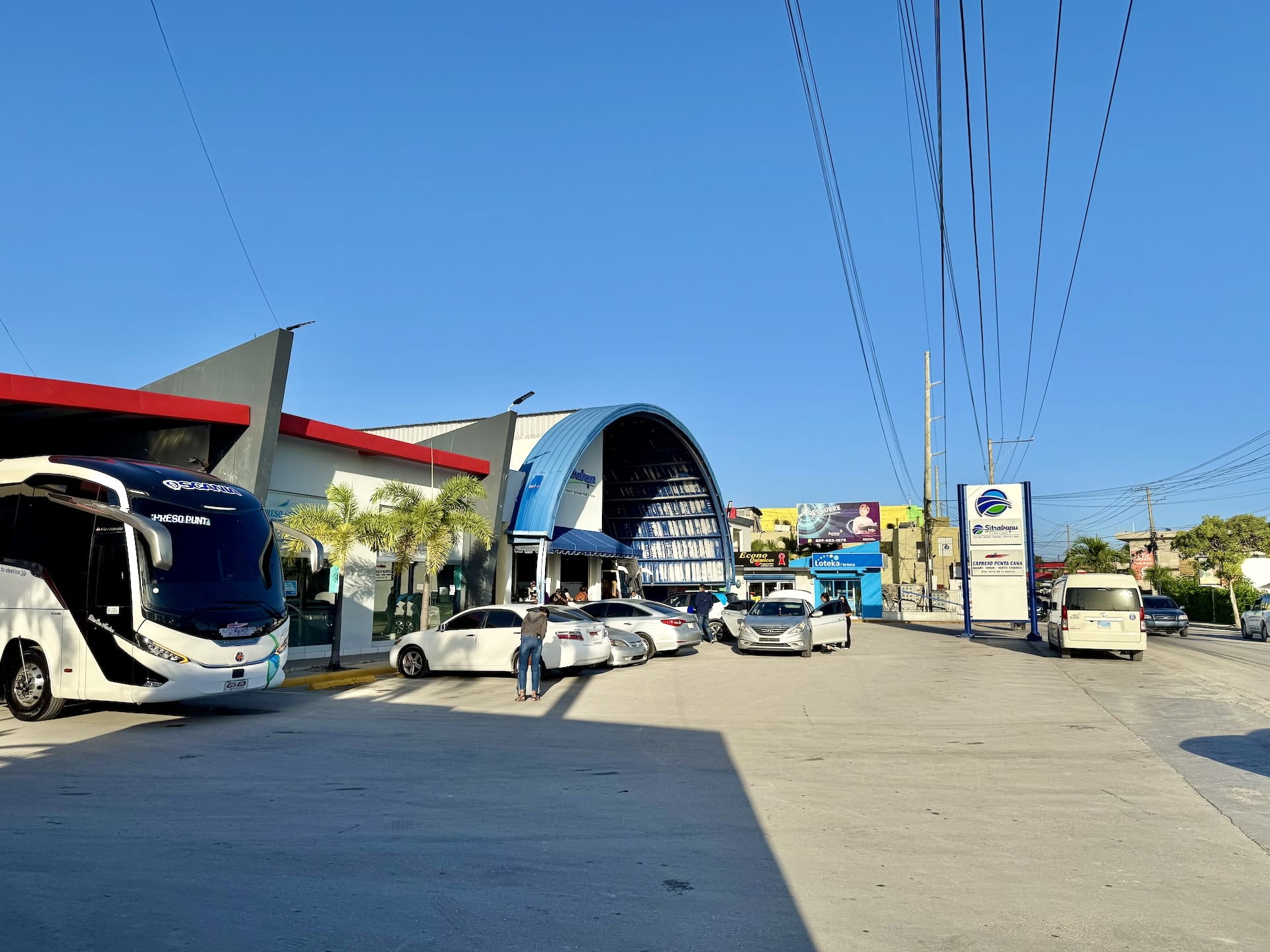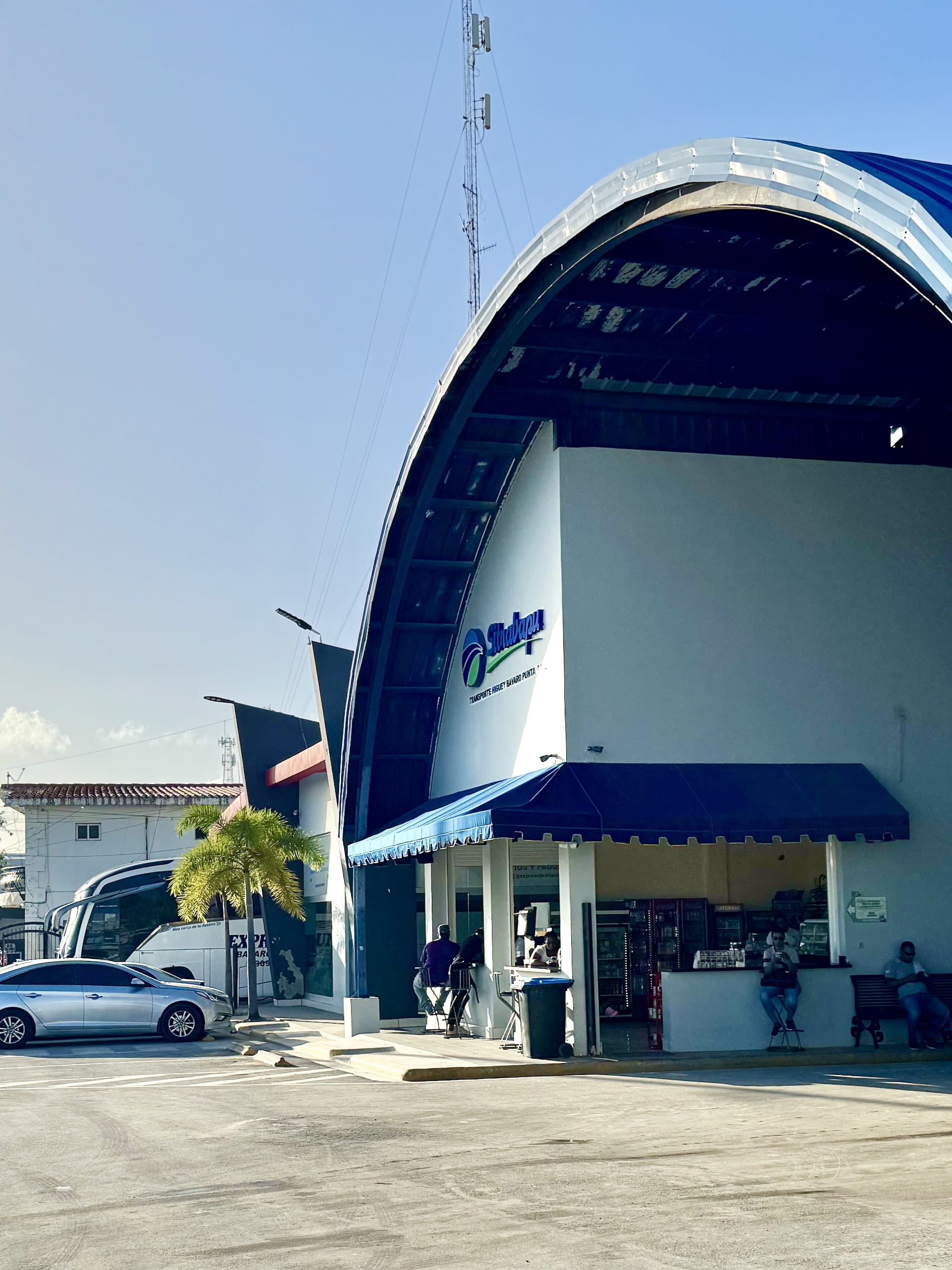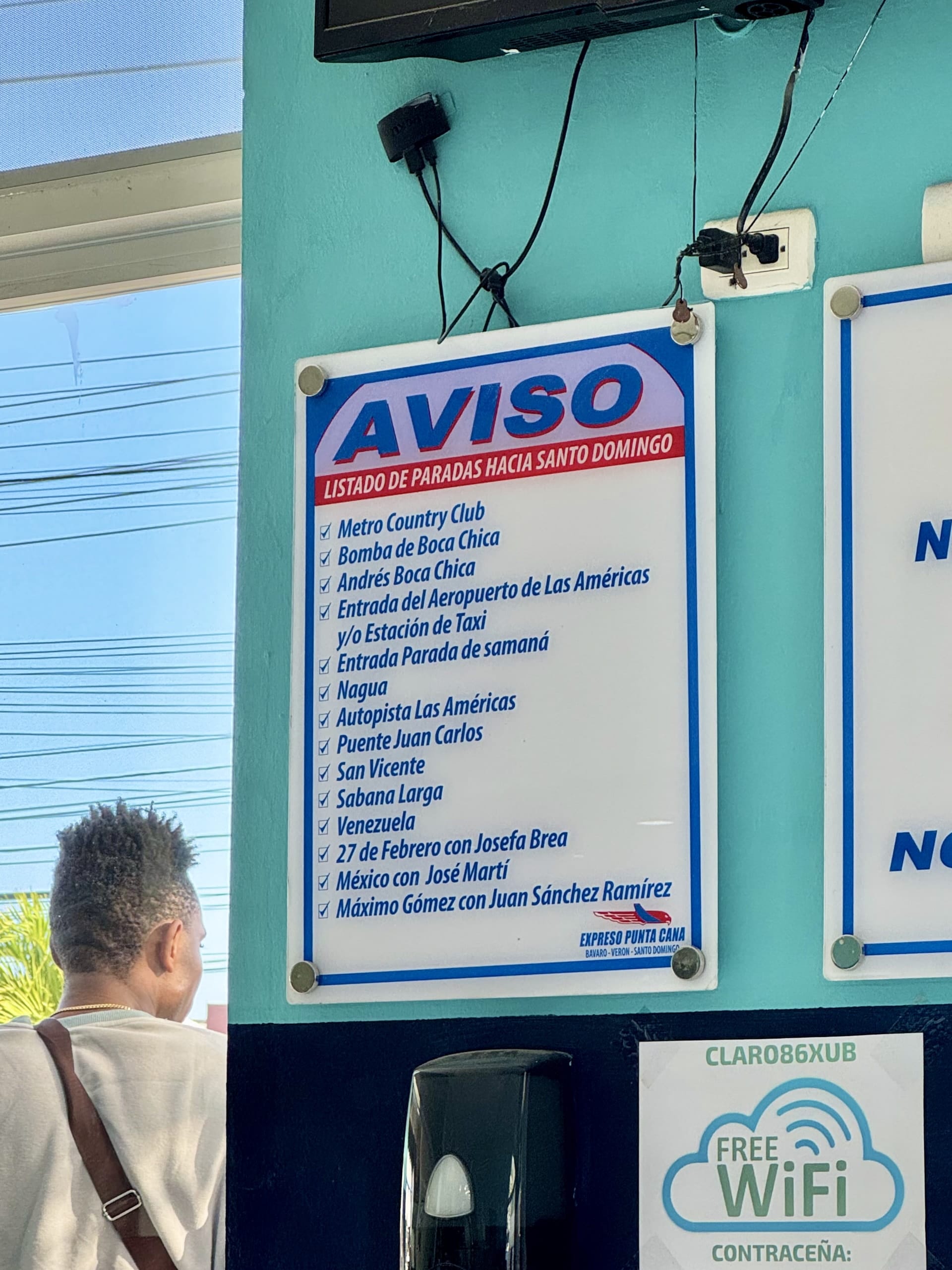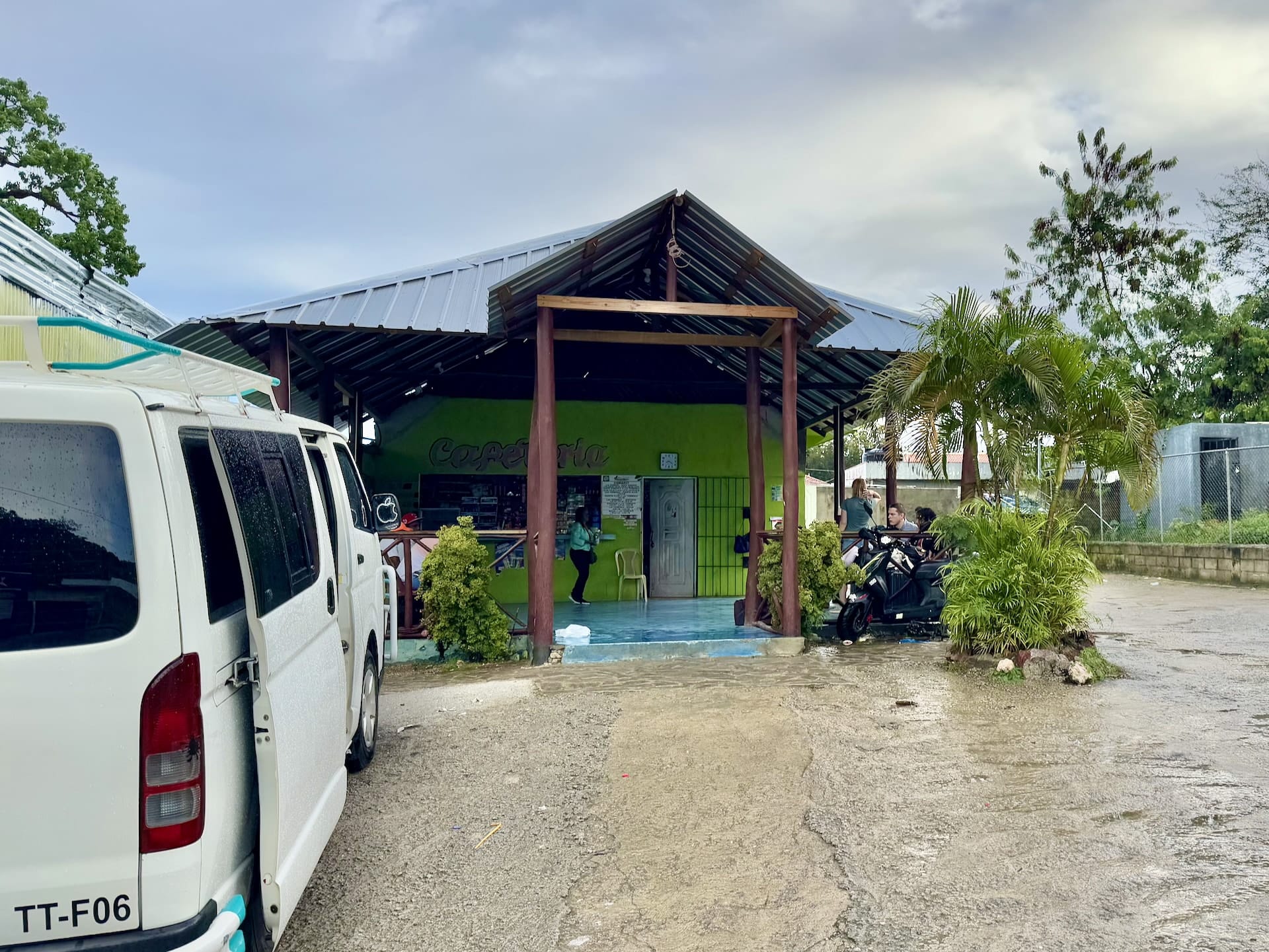After arriving in Punta Cana due to flight availability, we knew our two-week Dominican Republic adventure would begin there but wouldn’t end there. Resort lounging isn’t really our style – we prefer exploring countries more thoroughly and experiencing local culture – so after just two nights, we headed to Las Terrenas on the Samaná Peninsula in the northern part of the country, exactly as we had planned.
Exploring Your Transportation Options from Punta Cana to Las Terrenas
Before arriving, we tried to researche all possible ways to travel between these two destinations. Here were our options:
- Private transfer: Pay someone to drive us comfortably between the two locations. This would have cost around $300 USD, so we quickly ruled it out.
- Car rental: Have Andrea drive us. Several issues came up with this option: car rentals (particularly insurance) are surprisingly expensive in the Dominican Republic. Additionally, since we weren’t flying out of Punta Cana but rather Santo Domingo, we’d either need to drive to the capital and rent there, or find a company that would allow a different drop-off location for an additional fee. Finally, we’d heard horror stories about the Dominican Republic driving conditions and the country having the highest per capita rate of car accidents (though we later discovered these stories weren’t entirely accurate).
- The adventurous route: Take guaguas (local minibuses) to Sabana Del Mar, cross by boat to Samaná, then catch another guagua to Las Terrenas. This sounded exciting but would likely take an entire day, and since we weren’t yet familiar with local conditions, it seemed risky and uncomfortable.
- Bus route via Santo Domingo: Take a bus to Santo Domingo, then transfer to another bus to Las Terrenas.
I’m sure you can guess that we chose the last option, even though it meant a detour to Santo Domingo, which we had planned to visit at the end of our trip before departure. So, I’ll describe this route in detail to help you prepare if you decide to follow in our footsteps.
Getting to the Punta Cana Bus Station
If you’re not staying at a resort in Punta Cana, you’ll likely be based around the Bávaro area – that’s where we stayed. We were just a block from the beach, so our first step was getting to the bus station in town. This took about 15 minutes and cost 250 DOP (~$4.2 USD) by Uber, not including the tip.
Online research suggested arriving about 45 minutes before departure, which we did, though 20-30 minutes might be sufficient (though I wouldn’t risk cutting it closer). Whether the company is ultimately called Expreso Bávaro or Expreso Punta Cana remains a mystery to us, but it doesn’t really matter. The ticket counter is clearly marked at the station, where you can purchase tickets for 450 DOP (~$7.7 USD).
There’s another stop in Verón, which is closer to the airport.

Bus Schedule from Punta Cana to Santo Domingo
Here’s the schedule from Punta Cana (Friusa stop) to Santo Domingo:
- 7:00 AM
- 9:00 AM
- 11:00 AM
- 1:00 PM
- 3:00 PM
- 4:00 PM
You can supposedly buy tickets online at the Expreso Punta Cana website, but we purchased ours at the station. Credit cards are accepted. The 9:00 AM bus is particularly convenient as it allows you to comfortably make your connection in Santo Domingo. The journey is officially 2.5 hours, but this is Latin America after all – it took us about 3 hours and 15 minutes to reach the Santo Domingo stop near Parque Enriquillo (officially named México con José Martí).
When traveling from Punta Cana to Las Terrenas, consider taking the morning bus (9:00 AM) from Punta Cana to comfortably make your connection in Santo Domingo, as missed connections could mean waiting several hours for the next bus.
What to Expect on the Punta Cana Bus
The station offers comfortable, air-conditioned waiting areas with well-maintained restrooms and plenty of food and drink options, so the waiting time passes quickly until someone loudly announces boarding. (If nothing else, you’ll notice everyone suddenly jumping up and rushing the bus.) This happens about 15-20 minutes before departure.


Larger bags go in the lower compartment of the bus, and the cobrador (the bus attendant) gives you a numbered ticket in exchange, which you’ll need to present to retrieve your luggage when disembarking. I always feel a bit anxious when I have to store my backpack in the lower compartment of a bus that makes multiple stops, but the ticket system is reassuring.
There’s no assigned seating – it’s first-come, first-served. Interestingly, locals traveling together don’t seem to prefer sitting next to each other (they prefer sitting in front or behind), so two adjacent seats may not always be available. But everyone is very friendly, and if you ask nicely, the other passengers will surely help rearrange themselves. The bus was in good condition, comfortable, and air-conditioned.
On Dominican buses, a cobrador travels alongside the driver. This person essentially functions as a conductor who handles luggage, collects money for tickets (if purchased on the bus), and manages pretty much everything else.
The Journey to Santo Domingo
And we’re off! The buses supposedly have Wi-Fi – ours did, but our Dominican eSIM proved faster in terms of speed, and there was coverage in most areas along this section of the route. I was hoping the bus experience would be similar to Colombia, and fortunately, I wasn’t disappointed. Shortly after departure, phones appear, authentic Caribbean music (mostly bachata in our case) starts playing, some people hum or sing along, creating an excellent atmosphere.
I told Andrea that vendors would surely board during the journey, so we wouldn’t go hungry or thirsty (although our Bávaro hosts had packed excellent sandwiches for us), and indeed they did. You can purchase fruit juices, chips, nuts, and other snacks (dulce de leche!) from vendors who appear from time to time.
The first significant stop on the way to Santo Domingo will be the airport there (Aeropuerto Internacional Las Américas, SDQ), so you could also use this bus for travel to this airport. Shortly after comes the Parada Samaná stop. This is important to remember because if you’re running very late, you should consider getting off here. This is where the road branches toward Samaná (and Las Terrenas), meaning this is the starting point of Highway 7, which your next bus will use.
This is quite a suburban stop with a few shops and vendors nearby, so if you have time for the transfer, it’s worth continuing to Santo Domingo where the wait will be more interesting.
The cobrador announces upcoming stops by shouting them out and asks if anyone will be getting off – if not, the bus might simply not stop. Don’t worry, both Parada Samaná and the México/José Martí corner are popular stops, but to be sure (or if you want to get off elsewhere), it’s good to listen carefully or tell the cobrador in advance where you want to go. We also closely followed our location on our phone maps.
From here, it’s only about 20 km (12.4 miles) to downtown Santo Domingo, but depending on traffic and additional stops, this could easily take 40-50 minutes. When you arrive, you need to get off at the stop before the final destination, at the corner of Avenida México and Calle José Martí. Don’t forget your bags! From there, we simply walked to the other bus station about three blocks away, which took about 10 minutes.
Navigating Santo Domingo’s Bus Terminal
At first, the bustling Santo Domingo (not in its most upscale area) is quite shocking compared to the peaceful eastern coast, but there’s no need to be afraid. I should add that when we were returning from Las Terrenas, Andrea started filming the chaotic traffic at the intersection next to the station, when a very kind local man came over to warn us that a ladrón (thief) was coming and would snatch the phone from her hand (the phone was on a cross-body strap, so it wouldn’t have been successful or would have been quite uncomfortable). Lo and behold, when we later watched the video at our accommodation, you can actually see the ladrón approaching and then quickly changing direction after the warning. Many thanks to that unknown local hero!
In Santo Domingo, keep your valuables secure and avoid using your phone conspicuously on the street, particularly around the bus stations where pickpocketing can occur.
So, upon arriving at the station, we were greeted by considerable chaos. Buses were pulling in and out of tiny spaces, there was a lot of noise, and many people. The schedule is posted on the wall: you need to look for the “Las Terrenas / El Limón por el boulevard” buses. The departure times are:
- 8:30 AM
- 9:30 AM
- 11:00 AM
- 1:40 PM
- 3:00 PM
We targeted the 1:40 PM departure, which we comfortably made, arriving at the station around 12:30 PM. We chose this one because even if we missed it, there was still the 3:00 PM departure. The board also showed a partially covered “Las Terrenas” sign with a 6:00 PM departure, but we wouldn’t have wanted to rely on that. We asked a very kind elderly gentleman about the procedure (actually, he offered his help seeing our confusion in front of the schedule board), who then directed us to the cobrador of the 1:40 PM bus. He told us to sit in the waiting area, and he would notify us when boarding began.
That’s what we did. The waiting area is air-conditioned here too, with a small shop where you can buy the usual items. It’s less modern and inviting than in Bávaro, and although there is a bathroom, Andrea preferred to walk to the Plaza Lama shopping mall on the corner. There are additional vendors on the street in front of the station where you can buy food and drinks – when we were there, there was even churros!
The Bus Trip from Santo Domingo to Las Terrenas
Before Andrea returned from the mall, the cobrador indeed came into the waiting area and announced that loading and boarding could begin. The bags go into the bottom of the bus, just like in the previous case, but tickets are not purchased at a counter here – the fare is collected during the journey (cash only). As of early 2025, the fare to Las Terrenas was 500 DOP (~$8.5 USD) per person. This was also a comfortable, clean, air-conditioned bus (although we came back on a slightly more worn-out bus).
If you’re concerned about your luggage in the bus storage compartment, keep valuables in a small daypack with you and take a photo of your larger bags before they go into storage.
This journey was much less eventful, with only a single dulce de leche vendor boarding during the trip, and fewer stops. The final stretch of the road, however, offers beautiful views (it’s worth sitting on the left side of the bus)—from the heights, you can see the palm forest-covered northern coast of the Samaná Peninsula, and before that, the bus crosses hilly-mountainous terrain. Cell coverage was much more sporadic here. The journey took slightly less than 3 hours, so the delay was minimal.

Before reaching the final stop, the bus makes several stops in the “suburban areas” of Las Terrenas (primarily at accommodations), with the cobrador shouting out each stop name. We went all the way to the final stop, which is located on the edge of Las Terrenas. After disembarking, we were immediately swarmed by taxi drivers and motoconcho (motorcycle taxi) drivers. Our accommodation was near Playa Las Ballenas; taxi drivers quoted 500 DOP (~$8.3 USD) for this route, which we thought was too much, so we opted for a motoconcho for 300 DOP (~$5.1 USD). Yes, the two of us with a total of 4 backpacks on one small motorcycle. This ride turned into an impromptu city tour as our driver got completely lost – but that’s another story.
If you plan to return to Santo Domingo later, as we did, the bus will depart from here. It’s worth taking a photo of the schedule, but the departures are as follows:
- 5:00 AM
- 7:00 AM
- 9:00 AM
- 11:00 AM
- 2:00 PM
- 3:30 PM
Summary: The Complete Route from Punta Cana to Las Terrenas
To summarize the journey from Punta Cana to Las Terrenas:
- The first bus goes from Bávaro to Santo Domingo near Parque Enriquillo, taking about 3.5 hours and costing 450 DOP (~$7.7 USD).
- The second bus departs three blocks from there, with the journey to Las Terrenas taking about 3 hours and costing 500 DOP (~$8.5 USD).
- If you’re running very late, transfer at the Parada Samaná stop.
- The buses are comfortable and air-conditioned, with larger bags/backpacks stored in the lower compartment.
- It’s best to have cash ready—the second bus only accepts cash, though the first may accept cards.
- You can buy food and drinks at both stations, but vendors usually board the buses as well.

